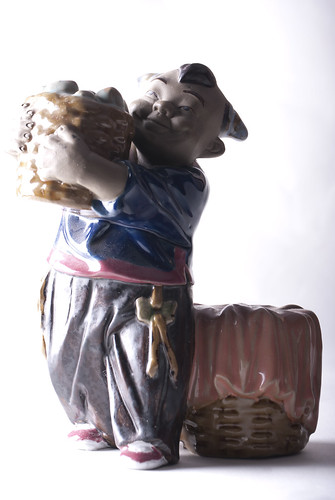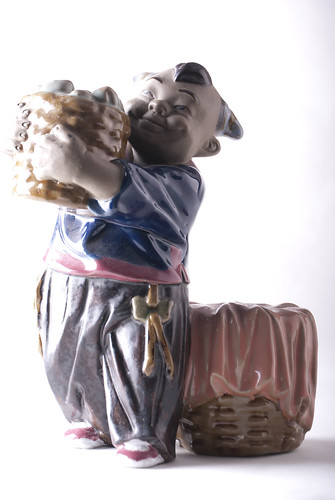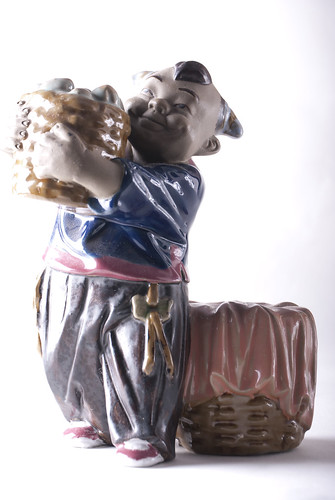Where: Inside the house with the outside light blocked by blackout curtains.
When: During the day.
How: I setup the still life with the camera locked off in a tripod pointing directly at the subject on the same level. I then started with a bare bulb flash and then worked through the exercise using a number of homemade reflectors and flags to demonstrate what happens to contrast and shadows when these items are used.
Up until now I had only really used a golden reflector and a black flag I had never tried to used white reflectors or silver reflectors, so I was interested in seeing what would happen.
Again I went back to the small Chinese statue as I wanted something with a lot of relief but also with a little shine on it so that I could see what happens to the light as it is reflected back from the subject from the reflectors.
With the camera in a fixed position and the lighting in a fixed position at right angles to the camera and at the same level as the subject, the exercise asked me use different reflectors and to move them back and forward to demonstrate that the amount of light reflected back was dependant on the reflector and its distance from the subject.
Bare Bulb
D80,Aperture f/9.5, Shutter Speed 1/180 sec, ISO 100, 66mm (35mm equivalent 99mm), Pattern Metering Mode, Flash White Balance, Tripod Mounted, 55-200mm lens

The first image is from a non diffused flash, just a bare flash bulb flash. I can see that there is a massive amount of light coming from the flash and it is overexposing the subject. The quality of light is hard to control in this case.
Diffused Flash
D80,Aperture f/9.5, Shutter Speed 1/180 sec, ISO 100, 66mm (35mm equivalent 99mm), Pattern Metering Mode, Flash White Balance, Tripod Mounted, 55-200mm lens

With a white umbrella fitted in front of the flash to act as a diffuser, the amount of light is reduced and the image is not as overexposed as the bare bulb image. I can see that there is a greater amount of contrast and that the subject has regained some detail and definition. I can also see that the side facing the flash is brighter than the opposite side where little light can reach, as the subject is divided into two unequal parts.
White Card One Meter Away
D80,Aperture f/9.5, Shutter Speed 1/180 sec, ISO 100, 66mm (35mm equivalent 99mm), Pattern Metering Mode, Flash White Balance, Tripod Mounted, 55-200mm lens

Using a large white card placed to the opposite side of the flash, I noted straight away that there was a certain amount of light reflected back into the subject. I can see areas, for example the sleeve on the statues which is now brighter and has less shadow on it as before. This has helped to balance the subject as it is no longer split down the middle with a light side and a dark side, the reflected light has filled in some of the shadows and helped to define the shape of the subject.
White Card Half a Meter Away
D80,Aperture f/9.5, Shutter Speed 1/180 sec, ISO 100, 66mm (35mm equivalent 99mm), Pattern Metering Mode, Flash White Balance, Tripod Mounted, 55-200mm lens

Moving the card in to half the distance away brings in even more fill light. I was really pleased to see this effect and I was surprised that the Inverse Square Law also worked for reflected light. By halving the distance the amount of reflected light had filled in all the shadows and had reduced the overall contrast of the image as there are now less dark parts to the image. I liked this overall effect which I had to admit I would only have been able to produced before by the use of two lights and a certain amount of work to balance the amount of light from each one.
Foil Reflector Dull Side Out
D80,Aperture f/9.5, Shutter Speed 1/180 sec, ISO 100, 66mm (35mm equivalent 99mm), Pattern Metering Mode, Flash White Balance, Tripod Mounted, 55-200mm lens

Again I was surprised, I thought that a dull reflector would reflect less light than a white card; I was surprised to see that it reflected even more light, but with a slight different hue. The fill light this time was not white and in this case did not wash out the statue with light. I can see that there is a difference in the blue hue of the statues sleeve and that the contrast levels of the image have again been reduced slightly.
Foil Reflector Shiny Side Out
D80,Aperture f/9.5, Shutter Speed 1/180 sec, ISO 100, 66mm (35mm equivalent 99mm), Pattern Metering Mode, Flash White Balance, Tripod Mounted, 55-200mm lens

Here things were as I expected, a lot of light was reflected back at the subject and the hue of the light is almost the same. I feel that the shadows are better defined and that the contrast of the image is better.
Crumpled Foil Reflector
D80,Aperture f/9.5, Shutter Speed 1/180 sec, ISO 100, 66mm (35mm equivalent 99mm), Pattern Metering Mode, Flash White Balance, Tripod Mounted, 55-200mm lens

I was very surprised when I reviewed this image as I somehow expected that the amount of reflected light to be less. However the crumpled foil has caused a slight scattering of the reflected light and this has meant that the fill light is diffused and not as harsh as the shiny foil. I like the effect that this has produced as the subjects contrast is a lot better than before without making the shadows too dark, the shadows now are better defined and the hues of the subject are not as over exposed.
What I learned out of this exercise is that reflectors can be used to bounce light back at the subject and that all reflectors have different usages due to the quality of the reflected light. I shall try to use reflectors a lot more now and continue to experiment as I believe that there is not one answer as to which reflector to use in what situation.
No comments:
Post a Comment